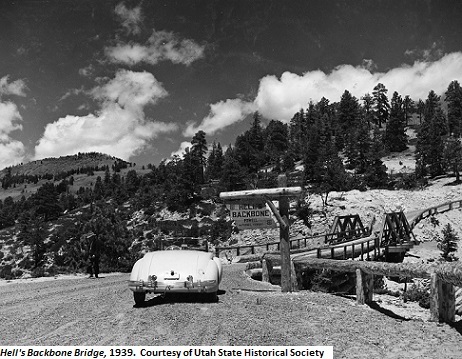Dublin Core
Title
Description
The celebration of the first all-weather road in Boulder, Utah, also celebrated the end of the small town’s isolation from the rest of the state. The remote location of the town meant that supplies and mail had to be transported on horseback or mule.
In June 1940, the residents of Boulder, Utah, turned out to celebrate the completion of the first all-weather road connecting their small town to the rest of the state. Since its settlement, Boulder had been a relatively remote outpost on the western margins of Garfield County. Supplies had to be packed in on horses or mules. Even the mail had to be picked up once a month by townsfolk willing to make the trip on horseback to Escalante. Of course, when the influenza epidemic of 1918 and 1919 finally reached south-central Utah, Boulder’s seclusion ended up being a boon as it enabled town leaders to institute an effective quarantine and keep the flu at bay.
Boulder became a little less isolated in the 1930s when the young men of the Civilian Conservation Corps, a Depression-era public works program, launched two ambitious road projects designed to connect the town not only with Escalante, but also with the communities of Wayne County to the north. Boulder residents had been pushing for a road as early as 1930, but it wasn’t until 1935 that roads over Boulder Mountain and from Escalante over Hell’s Backbone were finished. There was just one hitch with the two roads, however: neither was passable in winter weather. Thus work was started on the third or “Lower Boulder Road” and bridges were built spanning both the Escalante River and Calf Creek. Finally on June 21, 1940, work on the road wrapped up and the people of western Garfield County celebrated the end of what the local newspaper called the “last pack train mail route in the United States” and the opening of Boulder to year-round automobile traffic. Fittingly, the day was marked by an auto caravan, a barbecue, and an all-night dance party.
Creator
Source
Image: Hell's Backbone Bridge, May 18, 1939. Bridge connects towns of Escalante and Boulder, and opened up Boulder to year round traffic. Courtesy of Utah State Historical Society.
_______________
See the following editions of the Garfield County News: February 14, 1930; May 9, 1930; November 6, 1931; August 12, 1932; March 17, 1938; March 21, 1940; and June 13, 1950. Also see Linda King Newell and Vivian Linford Talbot, A History of Garfield County (Utah State Historical Society and Garfield County Commission, 1998), 181-191, 260, 288, 300, 302, and 310.

